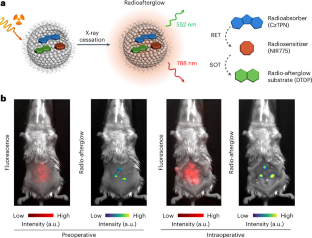用于癌症治疗的有机放射余辉纳米探针
IF 38.1
1区 材料科学
Q1 MATERIALS SCIENCE, MULTIDISCIPLINARY
引用次数: 0
摘要
利用 X 射线诱导典型的无机光学制剂产生长时间发光(放射余辉)和放射动力学效应,可在光线无法到达的组织深度进行诊断和治疗。现在,我们开发了一种级联 X 射线能量转换方法,以提高有机分子固有的低 X 射线转换效率,从而构建用于癌症治疗的放射余辉纳米探针。本文章由计算机程序翻译,如有差异,请以英文原文为准。

Organic radio-afterglow nanoprobes for cancer theranostics
Leveraging X-rays to induce prolonged luminescence (radio-afterglow) and radiodynamic effects from typically inorganic optical agents enables diagnosis and therapy at light-inaccessible tissue depths. Now, a cascade X-ray energy conversion approach is developed to increase the intrinsically low X-ray conversion efficiency of organic molecules for the construction of radio-afterglow nanoprobes for cancer theranostics.
求助全文
通过发布文献求助,成功后即可免费获取论文全文。
去求助
来源期刊

Nature nanotechnology
工程技术-材料科学:综合
CiteScore
59.70
自引率
0.80%
发文量
196
审稿时长
4-8 weeks
期刊介绍:
Nature Nanotechnology is a prestigious journal that publishes high-quality papers in various areas of nanoscience and nanotechnology. The journal focuses on the design, characterization, and production of structures, devices, and systems that manipulate and control materials at atomic, molecular, and macromolecular scales. It encompasses both bottom-up and top-down approaches, as well as their combinations.
Furthermore, Nature Nanotechnology fosters the exchange of ideas among researchers from diverse disciplines such as chemistry, physics, material science, biomedical research, engineering, and more. It promotes collaboration at the forefront of this multidisciplinary field. The journal covers a wide range of topics, from fundamental research in physics, chemistry, and biology, including computational work and simulations, to the development of innovative devices and technologies for various industrial sectors such as information technology, medicine, manufacturing, high-performance materials, energy, and environmental technologies. It includes coverage of organic, inorganic, and hybrid materials.
 求助内容:
求助内容: 应助结果提醒方式:
应助结果提醒方式:


